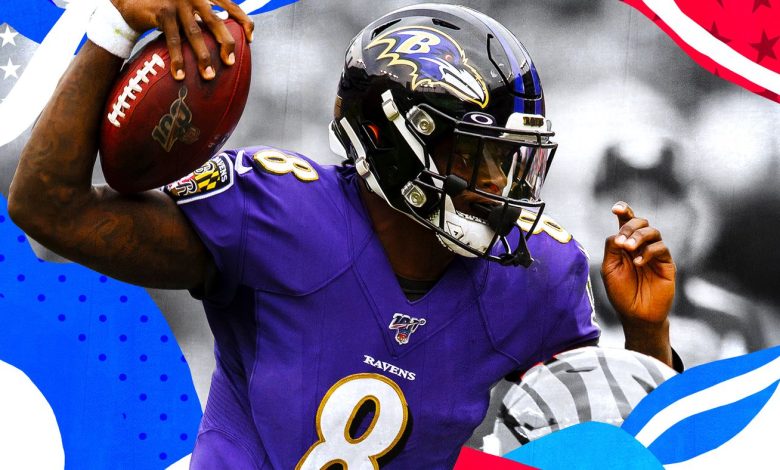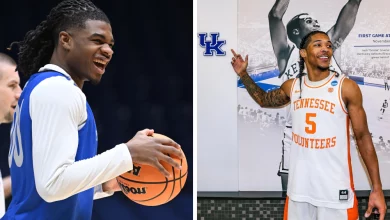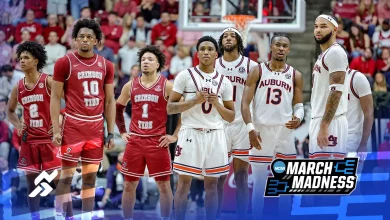Lamar Jackson’s 2018 NFL draft slide: How the league nearly missed a superstar.

When Lamar Jackson was selected with the 32nd overall pick in the 2018 NFL Draft by the Baltimore Ravens, few could have predicted the seismic impact he would have on the NFL. At that moment, Jackson was a polarizing figure, one of the most dynamic quarterbacks to ever grace the college football field, but still surrounded by skepticism. For a player whose talent was undeniable, Jackson’s fall to the last pick of the first round remains one of the most fascinating and baffling stories in NFL draft history. What went wrong in the draft process? How did so many NFL teams overlook a player who would go on to be a transformative talent?
In the years following the 2018 draft, Jackson’s meteoric rise to stardom and MVP status highlighted the flaws in the draft process and raised questions about the league’s approach to evaluating talent, particularly at the quarterback position. In this article, we will look at how Jackson, a player who led Louisville to impressive victories and shattered records in college, slipped to the bottom of the first round. More importantly, we’ll explore how the league nearly missed out on one of the most unique quarterbacks the NFL has ever seen.
The College Phenomenon
Lamar Jackson’s college career at the University of Louisville was nothing short of spectacular. He became the youngest player ever to win the prestigious Heisman Trophy in 2016, a feat that came after an outstanding season in which he threw for 3,543 yards and 30 touchdowns, and ran for an additional 1,571 yards and 21 touchdowns. Jackson was a dual-threat quarterback, a rarity in college football at the time, and his performances on the field often defied logic and reason. His speed, agility, and playmaking ability were unmatched. However, his unique style of play would later become the source of much debate.
Jackson’s playing style—heavy on improvisation, scrambles, and the threat of the run—was often viewed as unorthodox and difficult to translate to the NFL. The NFL has long favored pocket-passing quarterbacks, and Jackson’s ability to break out of the pocket and run was seen as a weakness rather than an asset. This view was compounded by the fact that Jackson, while an exceptional athlete, didn’t have the same polished, textbook mechanics that many teams desired in their quarterbacks.
Nevertheless, Jackson’s college success was undeniable, and as the 2018 NFL Draft approached, many expected him to be one of the top picks. However, that was not the case.
The Draft Process: A Baffling Slide
Leading up to the 2018 NFL Draft, Jackson was widely regarded as a top-tier quarterback prospect, but there was significant debate surrounding his skill set and potential fit at the next level. The questions about Jackson’s ability to transition to a pro-style offense loomed large, and many believed that his success at the collegiate level wouldn’t translate to the NFL. He had the athleticism, but could he be an effective pocket passer in the pros? Could he read defenses and adjust to the speed and complexity of the NFL?
Some of the most respected NFL draft analysts and scouts, including those from NFL Network and ESPN, were particularly critical of Jackson’s mechanics. They pointed to his low release point, inconsistent footwork, and tendency to lock onto his primary receiver as areas of concern. Others questioned whether he could develop into a proficient passer, as his college career had been more defined by his ability to make plays with his legs than his ability to dissect defenses from the pocket.
This skepticism was reflected in the way Jackson was treated in the lead-up to the draft. Several teams, including those who were in need of a quarterback, passed on him in favor of other prospects. The Cleveland Browns, New York Jets, and Buffalo Bills, all of whom had opportunities to select Jackson, chose quarterbacks who fit the traditional mold of a drop-back passer. Baker Mayfield, Sam Darnold, and Josh Allen were picked ahead of Jackson—players with varying degrees of upside but none of the dynamic dual-threat potential that Jackson brought to the table.
What made Jackson’s slide even more puzzling was the fact that he was clearly one of the most electrifying and successful quarterbacks in college football. Not only was he the reigning Heisman Trophy winner, but his college stats were absolutely eye-popping. Jackson finished his college career with 69 total touchdowns—50 passing and 19 rushing—and over 4,000 total yards in each of his final two seasons. In other words, Jackson was an incredible playmaker, but the NFL doubted whether his talents would translate to a pro offense.
The Ravens’ Vision
While Jackson’s fall down the draft board was shocking, it wasn’t entirely unexpected. The NFL has a long history of undervaluing unconventional quarterbacks who don’t fit the traditional pocket-passer mold. Teams had seen what Michael Vick could do with his legs, but still didn’t fully buy into the idea of a running quarterback. The likes of Colin Kaepernick and Robert Griffin III had shown flashes of brilliance in the NFL, but none of them had led their teams to consistent success over an extended period.
So, when the Ravens traded up to the 32nd overall pick to select Jackson, they were taking a bold leap of faith. At that point, Joe Flacco was still entrenched as the Ravens’ starting quarterback, and the team had no immediate need for a successor. But Baltimore saw something different in Jackson. Head coach John Harbaugh, offensive coordinator Marty Mornhinweg, and general manager Ozzie Newsome were all confident that Jackson could evolve into an elite quarterback and that the Ravens’ offense could be reshaped around his unique skill set.
In Jackson, the Ravens saw a player who could reshape their offense and breathe new life into the franchise. While other teams saw his style as a liability, Baltimore saw it as a weapon. The Ravens recognized the need for a quarterback who could make plays both inside and outside of the pocket, someone who could make defenders miss and take over games with their legs. In Jackson, they saw the future of the NFL—a quarterback who could thrive in an evolving league, one where offenses were becoming more dynamic and the need for versatility was greater than ever before.
The Start of Something Special
Once Jackson took over as the Ravens’ starting quarterback in his rookie season, it didn’t take long for the league to realize that they had severely underestimated him. Jackson brought an entirely new dimension to Baltimore’s offense. The Ravens implemented an offense designed specifically for Jackson’s strengths, leaning heavily on the running game while also allowing him to showcase his arm strength and accuracy on the move.
The results were immediate. In his first full season as a starter, Jackson led the Ravens to a 14-2 record, earning the NFL MVP award and setting multiple league and franchise records. He became the first quarterback in NFL history to rush for over 1,000 yards in back-to-back seasons, and his passing improved dramatically as he gained more experience. Jackson’s remarkable improvement as a passer helped elevate the Ravens’ offense into one of the league’s most potent units.
His ability to make defenders miss, extend plays, and keep defenses guessing was unmatched, and he quickly became one of the NFL’s most electrifying players. Jackson’s ability to beat teams both with his arm and his legs turned the Ravens into legitimate Super Bowl contenders year after year, with Jackson’s unique style of play giving them a distinct advantage.
The League’s Blind Spot
Looking back, it’s clear that the NFL’s reluctance to embrace Jackson’s talent was rooted in outdated thinking. The league, for so long dominated by traditional pocket passers, was slow to adapt to the changing nature of football. Teams were still clinging to the idea that a quarterback had to fit a particular mold in order to succeed, and Jackson’s nontraditional style didn’t fit into that mold. But in recent years, as more mobile quarterbacks have succeeded, it has become clear that the NFL’s understanding of what makes a great quarterback has evolved.
Jackson’s success has proven that a quarterback doesn’t need to conform to the traditional standards set by the league in order to succeed. His rise to stardom has reshaped the conversation around what it takes to be a successful quarterback in the modern NFL, and he has inspired a new generation of quarterbacks who can do it all: throw the ball, make plays with their legs, and keep defenses on their toes.









